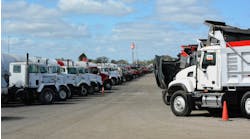The first wave of third-quarter financial reports indicates carriers are posting strong earnings. But driver shortages and fuel costs are continuing to dog business expansion in an otherwise positive economic recovery.
For instance, truckload carrier J.B. Hunt reported a 46% jump in year-over-year profits “despite historically high fuel prices that continued to rise during the quarter, a tight driver market that prompted driver pay increases.”
Tavio Headley, economist for the American Trucking Associations (ATA) told Fleet Owner that indicators point to carriers competing over the same pool of drivers, as opposed to a much-needed expansion in the number of drivers.
“In the second quarter of this year, the large truckload carriers had a turnover rate of 116%, compared to the small truckload carriers which are still high at 94%,” Headley said. The combination of high rates and driver shortages indicate that the pool of drivers hasn’t grown much.
“Making the problem worse is that there’s also the job competition from other industries such as warehousing and construction,” Headley said.
Chattanooga, TN-based truckload carrier Covenant Transport said in a phone conference explaining its quarterly report today that for the quarter, 5-6% of its fleet is unmanned versus last year when that figure was 0%.
“There is lots of freight that is not moving right now, so you have to believe shippers are going to come up to you and say, ‘give me a price to ship this freight and we’ll pay it’. Some decisions are going to have to made (about recruiting/retaining drivers) and I don’t know what the answer is,” said Joey Hogan, Covenant Transport CFO.
Volatile diesel prices have also been a drag on carriers’ bottom lines as fuel surcharges could not be raised fast enough to offset increases. Covenant Transport said it was able to recover 79% of the price hike, which on average amounted to a 39-cent increase over last quarter, said Covenant president & CEO David Parker.
“They (fuel surcharge adjustments) are more prevalent than they have been in the past,” said ATA’s Headley, noting the recent string of record-high diesel prices. “Despite the industry being at tight capacity, it’d still have the effect because fuel is typically the second-largest expense for carriers, accounting for 20-25% of operating costs.”


